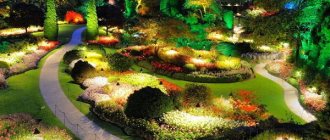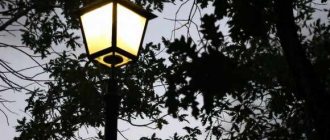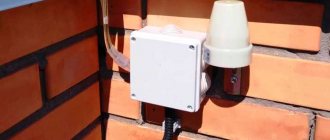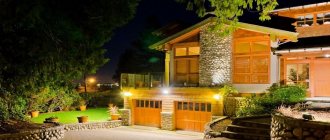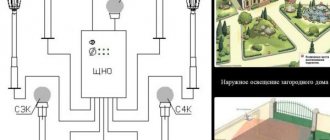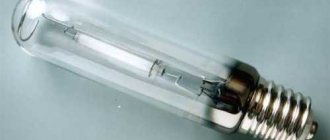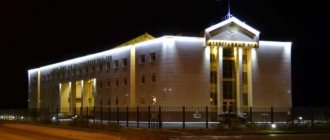In many countries, energy-saving technologies have been introduced over the past decades. Since 2012, a number of European countries have completely eliminated the use of sodium lamps, switching to LED lighting. You can read about the use of LED lighting in this article. In our country, this type of lamps is actively replacing not only sodium lamps, but also halogen ones, because with experience it has become clear that devices with LEDs are more economical and cheaper to use, despite the initially high price.
Today, not everyone has a complete understanding of how to choose street lamps, what characteristics they differ in, what is important to know before installation and how to achieve sufficient lighting.
Let's talk about the advantages and important technical indicators of LED lamps and answer the common question, what should street lighting be like?
Recommendations for choosing lamps
The following points will help when choosing artificial lighting, and you can learn about the types and types of lighting here:
- determine the main tasks that the artificial lighting source must solve;
- describe the design characteristics: fastening method, lamp power, material;
- find out the required level of protection from the external environment: level of protection from moisture, precipitation, dust. To do this, it is necessary to highlight the features of the environment in which the artificial light source will be used;
- choose the style of the product;
- study manufacturers, compare the advantages of available options;
- indicate the desired price.
Selection of lighting fixtures taking into account the type and purpose of lighting
Before purchasing an artificial lighting device, it is necessary to determine the purpose assigned to the device and its purpose.
Depending on the function, the lights can be:
- technical - have a discreet design, selected taking into account the brightness and completeness of lighting;
- decorative - installed to create lighting effects and as part of the interior of the space;
- universal - they combine two tasks: increasing visibility at night and decorative decoration of space.
Depending on the place of application, the lamp can be of the following subtypes:
- for street lighting (installed to illuminate important objects, meet high technical requirements);
Lamps for street lighting - for landscape lighting (solves a decorative problem);
- architectural (building lighting).
Lamps for illumination of buildings
Street lighting devices are divided into the following types:
- lanterns;
- decorative light source;
- spotlight.
What else to pay attention to before buying
When choosing budget street lighting, you need to consider:
- lamp service life . There is a mark on the packaging where the service life is indicated in the range from 50 to 100,000 hours. However, the final value depends on the temperature inside the device case. It is important to pay attention to heat dissipation, since high temperatures cause problems in operation and reduce the life of the lamp;
- Colorful temperature . The indicator falls in the range from 3,000 to 6,000 K. The choice may be based on the personal preferences of the buyer;
- color rendering This characteristic is not critical for street lighting. When installing lighting devices at important objects, it is better to choose a device with a color rendering index of at least 90. Modern devices have an index of at least 80;
- dimming _ The ability to change the brightness of the lighting is another important factor when choosing devices. To make adjustments, the built-in lamp driver must have a function that allows dimmer commands to be executed;
- Operating temperature range . Manufacturers often provide incorrect information on the device packaging. The minimum temperature cannot be lower than –40 degrees Celsius. On the label you can find a parameter of up to -60 degrees Celsius, which is not true. When choosing devices, keep an eye on this parameter;
- built-in sensors . Additional device functions: light, noise or motion sensor. These built-in capabilities allow you to expand functionality and increase energy savings. For example, increasing the light level when required.
Street lighting in rural areas
In the Russian Federation, quite a lot of attention is paid to the issues of lighting areas of residence. In cities, street lighting issues are not a global problem. But for villages and rural settlements, street lighting is a sore point. Often the problem of street lighting in rural areas reduces the quality of life of the population. The resolution of these issues is the responsibility of local authorities. In practice, citizens of small settlements have to contact different authorities to protect their rights. Difficulties arise due to the specifics of organizing lighting in rural areas. Lighting in rural areas differs from urban lighting in that the intensity of transport and human flow is lower here, and the number of trade, cultural, and administrative buildings is smaller. But, despite these factors, the system for ensuring an adequate level of illumination must ensure comfort for residents in the evening and at night.
Legislation on lighting in rural areas
Lighting in rural settlements falls under SNiP 23 – 05 – 95. This document establishes the standards by which outdoor lighting should be carried out.
In settlements located in rural areas, the following standards have been established: • for main streets - illumination level of at least 4 lux; • in areas adjacent to public buildings and in residential areas, the illumination level must also be at least 4 lux; • secondary streets and alleys - the level of illumination is reduced by half, i.e. not less than 2 lux; • village roads, driveways - at least 2 lux; • can be half as much and is only 2 lux. • secondary roads in rural areas may have an illumination of 1 lux; • gardening and vegetable gardening associations (roads and streets that are the main passages) are illuminated at a rate of 2 lux; • the area near a water source and fire hydrant located in a rural settlement is subject to mandatory lighting at a rate of 2 lux.
The specified standard values represent operational values. The illumination should not be less than the specified values. This applies to the entire period of operation. In different seasons, lamps can become dirty, so they need maintenance. Voltage fluctuations are possible in the electrical network, which can also affect the luminous flux. The illumination of the area can vary even depending on the height of the street lamps. All of these factors must be taken into account when planning lighting for areas in rural areas.
A new generation of equipment that drives various hydraulic equipment is the hydraulic pump oil station. Its scope of application is quite wide: drilling work, road work, lifting and moving large structures, supplying lubricant to machine components, pumping and filtering oils, testing hydraulic equipment and pipelines. Today, various models from both Russian and foreign manufacturers are presented on the domestic market. The modern Russian enterprise Pneumax offers to purchase unified hydraulic stations assembled with distribution hydraulic equipment of various models and dimensions pneumax.ru/hydrosystems/gidravlicheskie-nasosnye-stantsii/unifitsirovannye-maslostantsii-ctr-kv-sam-v-sbore-s-gidroapparaturoy/. Hydraulic oil stations have a lower cost because they do not require design and development costs.
Responsible for organizing street lighting in villages and villages
Resolution of issues related to the organization of street lighting is the responsibility of the Head of the rural settlement. His responsibilities include properly ensuring the organization of timely supply of electricity to supply light to rural streets. These duties are assigned to the Head of the settlement administration on the basis of the legislation on local self-government (Federal Law No. 131). The chairman of the village council must organize and control the process of lighting the territory in accordance with the standards. The issue of lighting relates to landscaping. This responsibility is directly assigned to the municipal authorities in accordance with the law. There is a social standard for illumination of the territory of a rural settlement. In accordance with this standard, the illumination rate is 80 percent. In some cases, in sparsely populated villages, a decision is made to install one pillar at the beginning of the territory (small streets), and a second pillar at the end. The head of a rural settlement must ensure illumination of socially significant objects - schools, preschool institutions. medical and obstetric centers, cultural institutions and other social facilities, if available.
Choosing lighting fixtures for rural areas
The decision to choose a lighting device is based on SNiP 2.07.01-89 standards. This document discusses urban planning standards, issues of planning and development of rural settlements. SNiP indicates that lighting devices must be installed in public areas. The number of lamps in a certain area is calculated based on lighting standards. When choosing the types of lamps that are equipped with lighting devices for rural areas, it is taken into account that it is difficult to maintain and replace lamps due to the territorial remoteness. Therefore, metal halide lamps, whose light output is high but have a short service life, are not suitable for rural areas. It is difficult and ineffective for service organizations to travel to remote areas to replace lamps.
It is preferable to opt for LED lamps: • the service life of such a light source is very long, approximately 50,000 hours; • high level of light output, since it is typical for LEDs to convert almost all received electricity into light; • low degree of energy consumption, which significantly saves energy costs; • the ability to choose color temperature: from cold shades to the usual warm ones.
Thus, when organizing lighting in rural areas, it is recommended to use LED lamps. The use of such light sources will reduce energy costs by reducing energy consumption and operating costs.
The long service life will ensure uninterrupted lighting of the area, which will affect the quality of life of the rural population. Another important factor is the possibility of implementing design solutions when lighting various areas of rural areas.
Installation of poles in rural areas
In order to provide the required level of illumination to the largest area, lamps are installed at the design height. Pillars are required for installation. Currently, poles for rural areas can be made:
• made of wood. The support is made of coniferous wood. The price of the poles is not high, they are easy to install. But the service life of wooden poles is not long. In addition, treatment with special compounds against rotting is required. • made of concrete. The cost of the support is low. They are distinguished by ease of use and durability. Groundwater poses a threat to concrete supports. Externally, such a pillar looks rough. • made of reinforced concrete. They are durable and resistant to corrosion. The price is higher than concrete ones. Externally, they are practically no different from concrete supports. • Made of metal. They are distinguished by durability, strength, stability and aesthetic appearance. But the price for such supports is quite high..
When installing pillars, it is necessary to control the production of the foundation. When installing light poles, due consideration must be given to the foundation. Depending on the installation location, the depth should be from 0.8 to 1.6 meters. For rural areas, a solid foundation is an additional guarantee of lighting quality. The pole is placed from the curb at a distance of 0.3 to a meter, depending on the purpose of the road.
If there is a problem with lighting in rural areas
Often in rural areas there is a situation with a lack of lighting or even a complete absence of light. What measures can residents take? Initially, a complaint is filed with local authorities. The complaint must be accepted, but there may not be a response. The next step is a complaint to the supervisory authorities. Those. Residents should contact the prosecutor's office or judicial authorities directly. The statement states. that there is a lack of coverage and a lack of response from local authorities to citizens’ appeals. The basis for contacting supervisory and control authorities or the court is the Federal Law of the Russian Federation No. 131, which clearly states that resolving local issues is the responsibility of local governments. The judicial authorities or the prosecutor's office review the application and make a decision to correct the problem. The decisions of these bodies are binding on local authorities. It should be noted that local authorities are not always able to comply with court decisions and orders due to lack of funds.
So, the problems of lighting rural areas have their own specifics - remoteness of the territories, difficulties in maintenance, high costs of maintaining and operating lighting devices. However, in recent years the situation has changed for the better.
LED lamp protection class
The lamp body is quite strong, stable and able to withstand a certain load coming from the environment. But the level of protection of devices can vary greatly - when choosing a device, you should remember this parameter and focus on the intended operating conditions of the lamp.
Luminaires differ in class, which is assigned based on the IEC-952 standard for protection against external factors.
The first digit of the indicator indicates the level of resistance of electrical equipment to solid particles, the second value indicates resistance to moisture. The exact data can be studied in the table with a complete description of the degrees of IP protection that can be found on the World Wide Web. Based on the calculation of street lighting illumination and the indicators given in the table, you can make decisions about installing one or another type of lamp in the given conditions. To illuminate an area near the water, it is better to choose a lamp with protection class IP66, and for lighting a summer cottage, a lamp of IP64 class is suitable.
Street lighting standards
Street lighting standards are mandatory during design. Basically, street lighting standards concern the brightness and illumination of highways. The division occurs based on the categories of objects. Therefore, before looking for the desired value, it is necessary to determine the class of the road in accordance with existing documentation. If this is not possible, you can use the simplest indicators as a guide: the number of lanes and approximate throughput.
p, blockquote 1,0,0,0,0 –>
These standards and regulatory documents apply to outdoor street lighting and establish the classification and standards for lighting of street network facilities within the territories of urban and rural settlements. These standards must be used when designing and operating stationary street lighting installations.
p, blockquote 2,0,0,0,0 –>
p, blockquote 3,0,0,0,0 –>
p, blockquote 4,0,0,0,0 –>
p, blockquote 5,0,0,0,0 –>
p, blockquote 6,0,0,0,0 –>
Power and luminous flux
Different areas of the territory require different levels of illumination. When developing a lighting plan for important public areas (roads, driveways, stadiums), calculations are made of the required luminous flux, the number of lighting devices and their efficiency, based on street lighting rules.
The illumination of a space is measured in lux (lux) by a specialized device - a luxmeter.
Luxmeters
SNiP 05/23/2010 indicates calculations of the appropriate level of illumination for various objects. Street lighting must comply with strictly specified standards. The device is installed with an additional reserve, since after time the luminous flux decreases.
The illuminance index is related to the amount of luminous flux, measured in lumens (lm). This is the amount of light power that the light source in question can provide. The level of illumination directly depends on the luminous flux indicator. These quantities are directly proportional.
Answering the question: how to calculate street lighting, mention should be made of calculating the required amount of luminous flux. To calculate, you will need to have the following indicators:
- required level of illumination;
- the area of the land;
- distance from the light source to the surface;
- radiation angle.
Specialized calculators are used for calculations.
In the instructions and description of the lamp, both the luminous flux (lm) and luminous efficiency (the ratio of light to 1 W of power) are indicated. LED lamps are characterized by economical energy consumption. To provide a luminous flux of 7500 lm, a sodium lamp must have a power of at least 180 W, while an LED lamp must have a power of at least 80 W.
Luminous efficiency (lm/W) is inversely proportional: the higher the value, the more economical the device. The maximum value reaches 100 lm/W.
Street lighting standards
Below are general lighting standards for all types. They should definitely be taken into account when designing street lighting.
p, blockquote 21,0,0,0,0 –>
Street lighting standards in the city
p, blockquote 22,0,0,0,0 –>
p, blockquote 23,0,0,0,0 –>
| № | Illuminated objects | Average illumination Ecp, lux not less | Illumination distribution Emin / Eсr not less |
| 1 | P1 . Areas in front of entrances Areas in front of entrances of cultural, sports, entertainment and shopping facilities, sports, entertainment and shopping facilities | 20 | 0,30 |
| 2 | P2 . The main pedestrian streets of the historical part of the city and the main public centers of administrative districts, impassable and in front of factory squares, landing areas, children's and recreation areas | 10 | 0,30 |
| 3 | P3 . Pedestrian streets, main and auxiliary entrances of parks, sanatoriums, exhibitions and stadiums | 6 | 0,20 |
| 4 | P4 . Sidewalks separated from the roadways of roads and streets, main passages of microdistricts, entrances, passages and central alleys of children's, educational and health care institutions | 4 | 0,20 |
| 5 | P5 . Secondary passages in the territories of microdistricts, utility areas in the territories of microdistricts, side alleys and auxiliary entrances of city-wide parks and central alleys of parks of administrative districts | 2 | 0,10 |
| 6 | P6 . Side alleys and auxiliary entrances of parks of administrative districts | 1 | 0,10 |
p, blockquote 24,0,0,0,0 –>
What not to do with street lamps
When working with the installation and operation of street light sources, you should remember safety measures. The following list will help you work safely:
- installation of devices should be carried out after turning off the power supply;
- When working with lighting devices, hands must be completely dry from moisture;
- No moisture or drops of water should enter the device housing. Due to violation of safety precautions during installation, a short circuit may occur;
- all electrical connections must first be insulated from moisture;
- When working, it is important to pay attention to the serviceability of the electrical wiring. If it is damaged, it is prohibited to connect devices;
- The light source must not be installed with the glass facing up;
- street lamps and spotlights are prohibited from being installed or connected in the immediate vicinity of chemicals and various flammable substances;
- if the cable insulation or the device casing is damaged, its installation and operation for its intended purpose is impossible;
- The light source should be turned off if the light begins to flicker or the brightness decreases suddenly.
It is important to remember that any mechanical damage to the device body can trigger an electric shock.
What parameters should be taken into account when choosing street lamps
Street lighting systems include the following parameters:
- purpose – its characteristics will depend on the purpose and location of installation of the device;
- technical properties;
- aesthetic parameters;
- efficiency - the most economical solution is LED devices and solar-powered devices;
- lighting area;
- type of construction and fastening;
- lifetime.
Street lighting fixtures must be placed in accordance with legal regulations.
What kind of light bulbs are used in street lamps?
The following types of lamps are used in street lighting devices:
- gas-discharge - mercury, xenon, sodium, neon;
From left to right: mercury, xenon, sodium, neon
- luminescent - economical, have a long service life, cannot withstand low temperatures;
Fluorescent lamps
- LED - have a long service life (up to 25 years), are economical, do not flicker.
LED lamp and luminaire
Outdoor lighting temperature
Varieties of color temperature:
- 2700-3000 K – warm light;
- 3500-4100 K – daylight;
- 5000-6500 K – cold light.
To illuminate public areas, devices with a color temperature from 2700 to 4100 K are installed.
Lamps with cold light are installed in stadiums, gas stations and for architectural lighting.
Types of street lamp design
When buying a lighting device, pay attention to the design features of the lighting device:
- street lamp and floor lamp - has a support mast with a lampshade installed on it;
- wall mounting - spotlights for architectural lighting, can be elements of decorative finishing of the facade;
- pendant lamps - used to illuminate the landscape;
- ground devices - installed for landscape lighting or territory decoration, built into the ground;
- built-in light sources - used to illuminate individual elements, installed for decorative purposes.
Requirements for lighting brightness
The decisive factor is the horizontal illumination of the coating. Roads are divided into groups based on the average values of this parameter under various conditions:
- Group A, which includes major highways and main city streets/roads. The indicator of horizontal illumination of the road surface must correspond to a value within the range from 15 to 20 lux.
- Group B. This includes streets of district significance (10-15 lux).
- Group B: local streets/roads (4-6 lux).
In addition, traffic volume is taken into account to determine the required degree of lamp protection on poles.
So, if the number of passing vehicles exceeds 2,000 units/hour, then the lamp must have a protection degree of IP 54. This is due to the fact that such roads are very dusty. Street lighting poles
must be manufactured according to KMD detail drawings, based on the KM brand drawings developed by the design organization.
Lighting poles
classified by:
- material - steel;
- purpose - carriers;
- types of connections - bolted, welded;
- degree of factory readiness - manufactured at the enterprise in the form of shipping elements (assembled in a package) and enlarged during installation;
- type of force impact - those that perceive constant, variable and episodic loads;
- degrees of aggressiveness: operated in non-aggressive, slightly aggressive and moderately aggressive environments;
- the presence of a hinged device - folding (mobile) and stationary;
- number of sections - single-section and multi-section;
- the shape of the stand profile is round and multifaceted;
- type of sealing of racks - installation on the foundation and installation in the ground.
Folding light pole
consists of two parts: fixed and movable. Free rotation of the moving part relative to the stationary one is ensured using a hinge device
Lighting pole stand
up to 12 meters high inclusive, consists of one section. In this case, the support leg will be the starting mark. A support post with a height of more than 12 meters consists of several sections (more than one). In this case, the starting mark will be the section. The lighting column must be a truncated pyramid with a multifaceted (six or more faces) or circular cross-section, and must be manufactured by sheet bending followed by longitudinal welding.
Smart lighting
To automate the processes of turning on/off lighting in order to save energy, the following are used:
- photo relay - turns on the light source at dusk and turns off at dawn;
- astronomical relay - switches the device based not on the light level, but on the geographic coordinates of the area, which are entered manually;
- motion sensor – turns on the lighting when motion is detected in a given range;
- temporary relay – provides for manual activation of the system and automatic shutdown after a specified time period.
Useful tips
Choosing devices for street lighting:
- incandescent lamps have a short service life and consume large amounts of electricity;
- devices with gas-discharge lamps illuminate the landscape in the best way;
- for parks it is better to use halogen lamps;
- LED lights have low energy consumption and produce a strong luminous flux.
When choosing a device, it is necessary to formulate operational requirements for lighting and study the technical data. When purchasing lamps, you should ask for the manufacturer’s accompanying documentation, paying special attention to the technical indicators of the LEDs.
When choosing and purchasing lamps, have a lux meter and a multimeter with you - this will allow you to check the declared characteristics on the spot and buy a lamp that meets the parameters.
